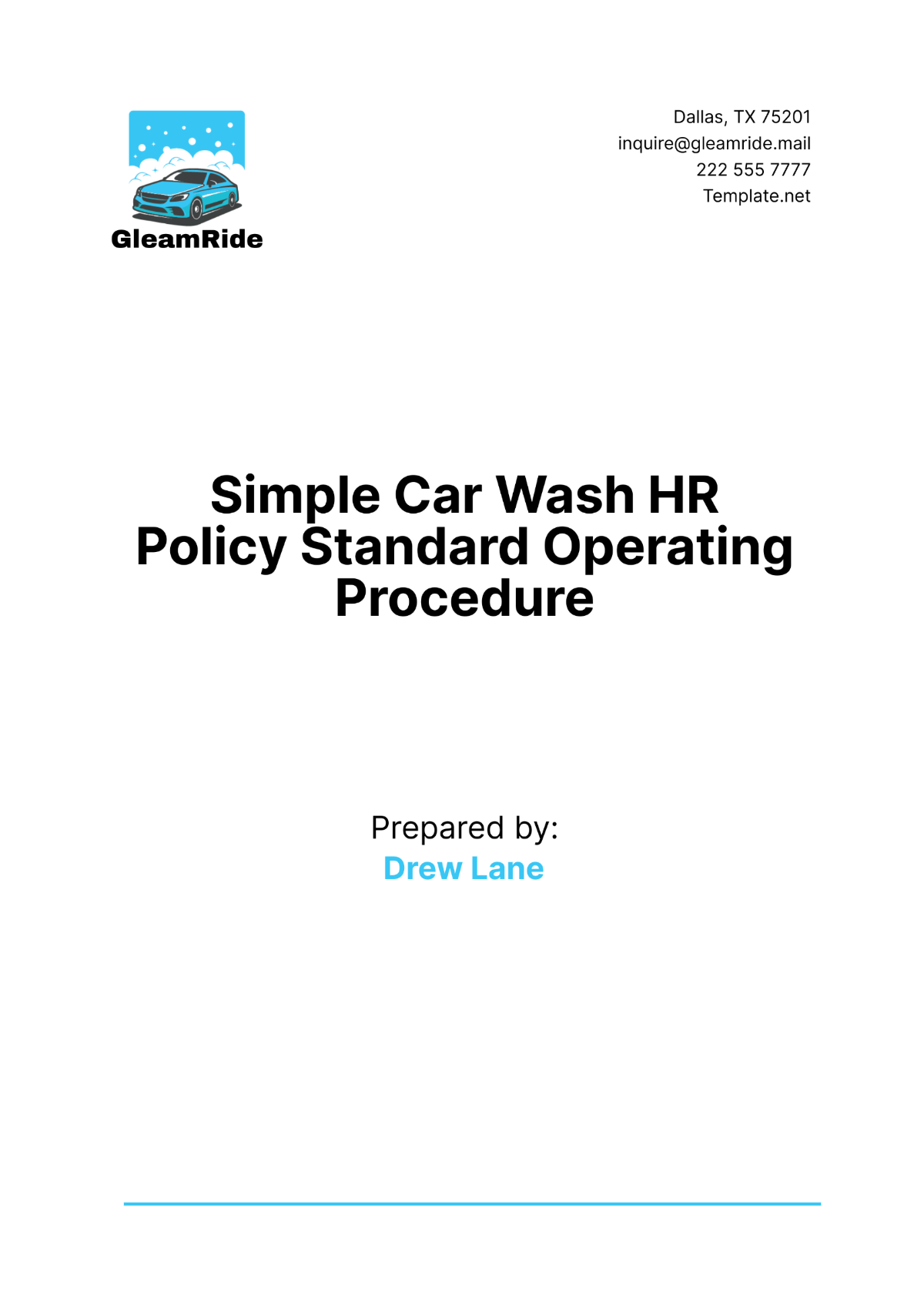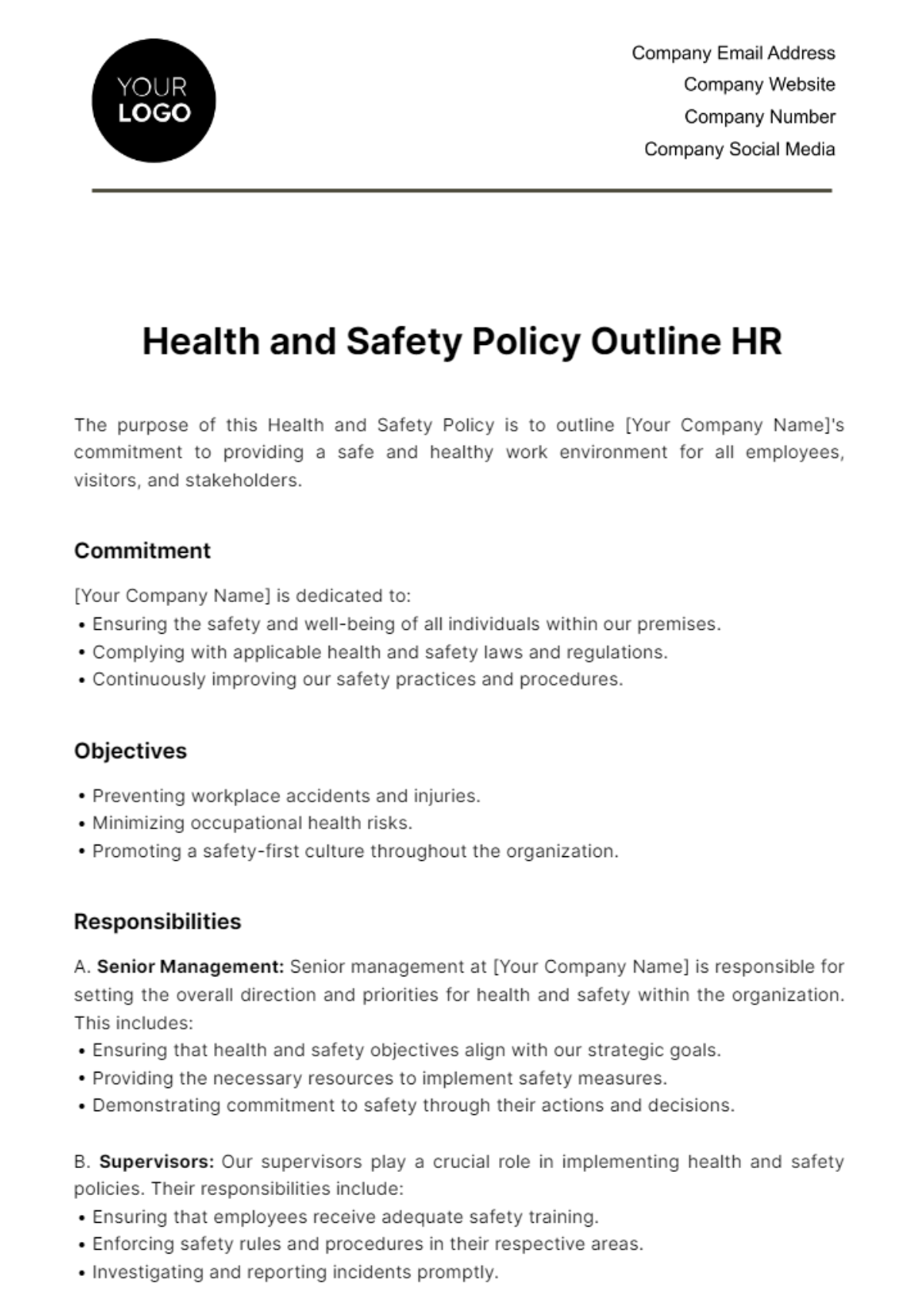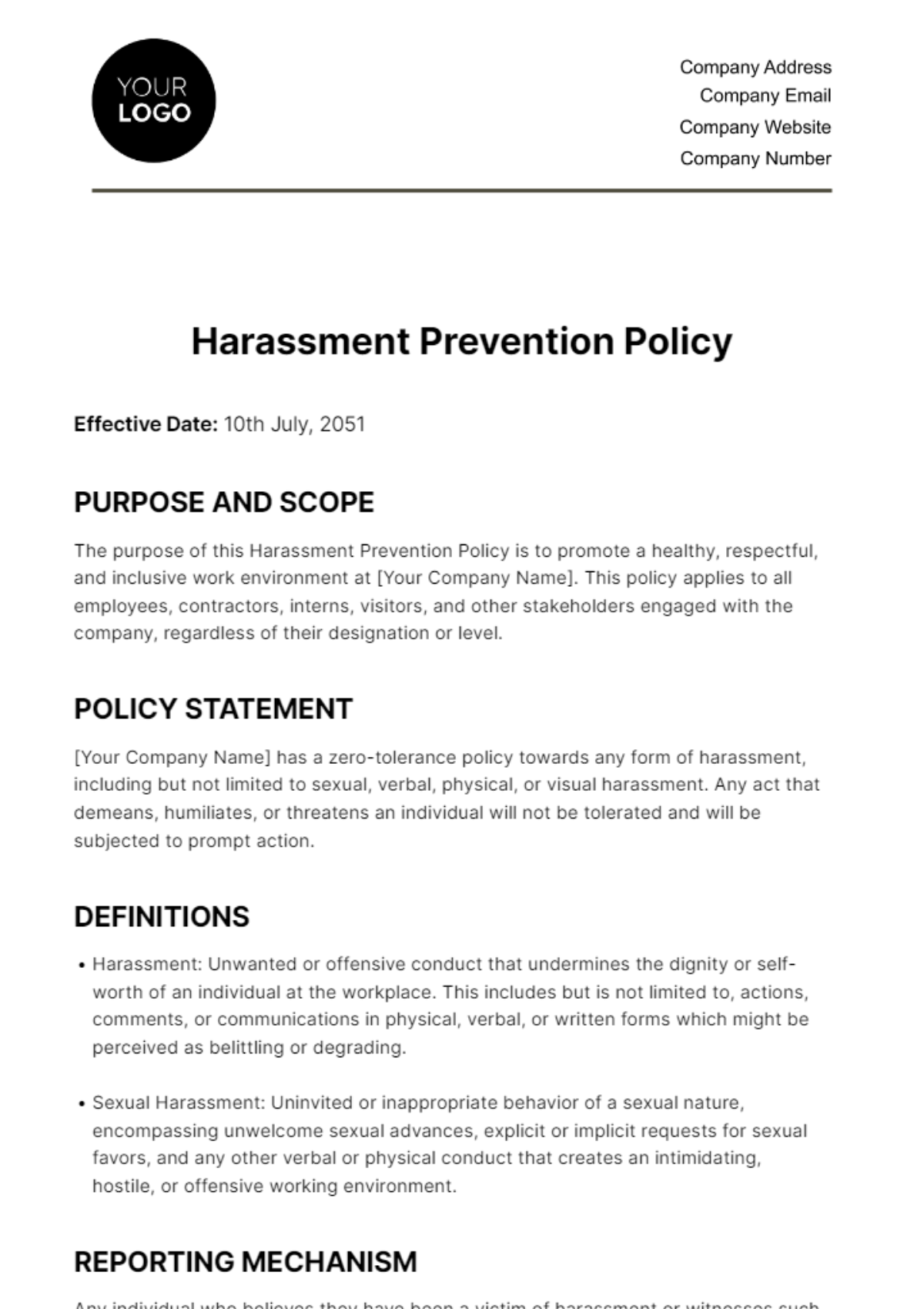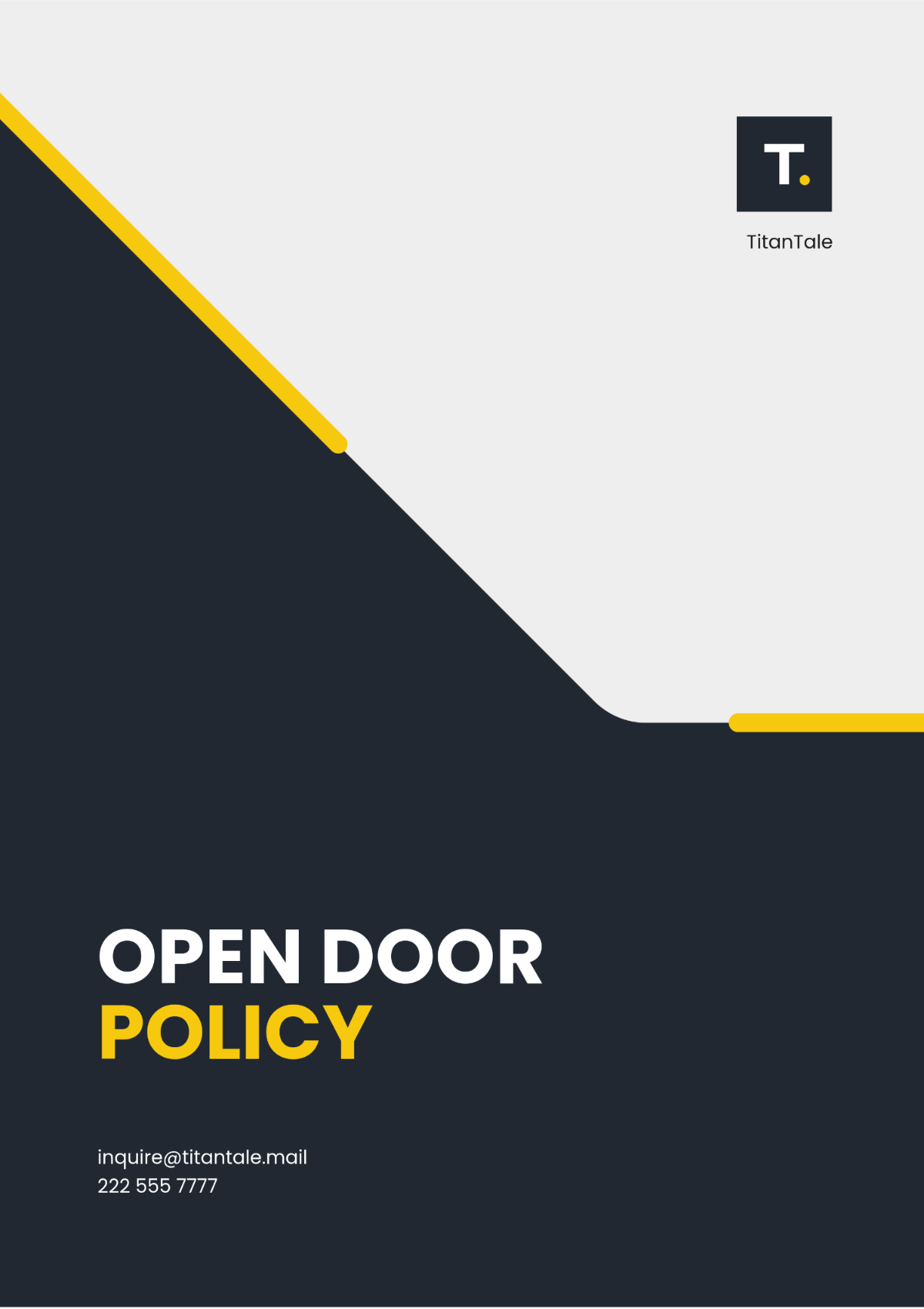HR Policies and Procedures
I. Introduction
[Your Company Name] believes that our employees are our most valuable asset. Our HR policies and procedures are designed to foster a positive work environment, ensure compliance with applicable laws, and promote fairness and consistency across all HR-related activities. These guidelines serve as a framework to support our employees' growth, well-being, and success within the company.
A. Purpose
The purpose of this document is to outline the human resources policies and procedures at [Your Company Name]. These policies are intended to provide guidance on various aspects of employment, including recruitment, benefits, performance management, and workplace conduct.
B. Scope
This document applies to all employees of [Your Company Name], regardless of their position or tenure. It is designed to ensure consistency in the application of HR practices across the organization.
II. Recruitment and Selection
Our recruitment and selection policy is aimed at attracting and hiring the best talent to meet the current and future needs of [Your Company Name]. We are committed to a fair, transparent, and merit-based hiring process.
Job Posting and Advertising: All job openings will be posted internally and externally, ensuring equal opportunity for all candidates. Job descriptions will clearly outline the required qualifications, skills, and responsibilities.
Application Process: Candidates are required to submit a resume and cover letter, which will be reviewed by the HR department. Shortlisted candidates will be invited for interviews, which may include multiple rounds and assessments.
Interview and Selection: Interviews will be conducted by a panel including HR and department heads. The selection process will be based on the candidate's qualifications, experience, and fit with the company culture.
Offer and Onboarding: Selected candidates will receive a formal offer letter outlining the terms of employment. The onboarding process will include orientation, training, and introductions to the team.
III. Compensation and Benefits
[Your Company Name] offers a comprehensive compensation and benefits package designed to attract, retain, and motivate our employees. We believe in rewarding our employees fairly for their contributions to the company’s success. The following table outlines the key components of our compensation and benefits package.
Component | Eligibility | Frequency |
|---|---|---|
Base Salary | All employees | Bi-weekly/Monthly |
Performance Bonuses | Eligible employees (based on role) | Annually/Quarterly |
Health Insurance | All full-time employees | Continuous (upon enrollment) |
Retirement Plans | All full-time employees | Monthly (Employer contribution) |
Paid Time Off (PTO) | All employees | Accrued Annually |
Sick Leave | All employees | Accrued Annually |
Maternity/Paternity Leave | Eligible employees | As per company policy |
Professional Development | Eligible employees | As per request and approval |
Tuition Reimbursement | Eligible employees | Upon completion of coursework |
Employee Assistance Program (EAP) | All employees | Continuous (upon request) |
The compensation and benefits package at [Your Company Name] is designed to be competitive within the industry while also supporting the overall well-being of our employees. The company offers opportunities for professional growth through tuition reimbursement and development programs, emphasizing our commitment to the career advancement of our staff.
Salary Structure: Salaries will be determined based on the role, experience, and market standards. Regular salary reviews will be conducted to ensure competitiveness.
Benefits Package: Employees are entitled to a range of benefits, including health insurance, retirement plans, and paid time off. Detailed information about benefits is provided in the employee handbook.
Bonuses and Incentives: Performance-based bonuses and incentives may be awarded to employees who meet or exceed their targets. The criteria for bonuses will be communicated clearly to all employees.
Payroll Procedures: Salaries will be paid bi-weekly/monthly via direct deposit. Any payroll discrepancies must be reported to HR immediately for resolution.
IV. Performance Management
Performance management at [Your Company Name] is focused on continuous improvement and development. We aim to provide clear expectations, regular feedback, and opportunities for growth to all employees.
Performance Appraisals: Annual performance reviews will be conducted for all employees to assess their achievements and areas for improvement. The appraisal process will include self-assessment, manager feedback, and goal setting for the upcoming year.
Goal Setting and Development Plans: Employees will work with their managers to set achievable and measurable goals aligned with company objectives. Individual development plans will be created to support career growth and skill enhancement.
Feedback and Coaching: Managers are encouraged to provide regular feedback and coaching throughout the year. Constructive feedback should be aimed at helping employees improve and succeed in their roles.
Addressing Performance Issues: If performance issues arise, a formal performance improvement plan (PIP) may be implemented. The PIP will outline specific areas for improvement, a timeline, and support resources available to the employee.
V. Workplace Conduct and Ethics
[Your Company Name] is committed to maintaining a professional, respectful, and ethical workplace. Our code of conduct outlines the expected behavior of all employees and sets the standard for our organizational culture.
Professional Behavior: Employees are expected to behave professionally at all times, treating colleagues, clients, and partners with respect. Any form of harassment, discrimination, or unethical behavior will not be tolerated.
Dress Code: A business casual dress code is in place, with exceptions for specific roles or occasions. Employees should dress appropriately to reflect the company’s image.
Conflict of Interest: Employees must avoid situations where their personal interests conflict with the interests of the company. Any potential conflict of interest must be disclosed to HR immediately.
Confidentiality and Data Protection: Employees are required to protect the confidentiality of company information and client data. Proper protocols must be followed for handling sensitive information, both digitally and physically.
VI. Leave Policies
Our leave policies are designed to support the well-being and work-life balance of our employees. [Your Company Name] offers a variety of leave options to accommodate different needs and circumstances.
Paid Time Off (PTO): Employees are entitled to PTO, which can be used for vacation, personal days, or illness. PTO accrual rates are based on the length of service and role within the company.
Sick Leave: Employees are entitled to sick leave in the event of illness or medical appointments. A doctor's note may be required for absences exceeding three consecutive days.
Maternity/Paternity Leave: Paid maternity and paternity leave is provided to eligible employees following the birth or adoption of a child. Leave duration and pay are determined based on company policy and local regulations.
Unpaid Leave of Absence: Employees may request an unpaid leave of absence for personal reasons, subject to approval by HR. The length and terms of the leave will be discussed on a case-by-case basis.
VII. Training and Development
[Your Company Name] is dedicated to the continuous learning and development of our employees. We provide training programs and development opportunities to help our employees grow professionally and stay competitive in the industry.
Orientation and Onboarding: New hires will undergo an orientation program to familiarize them with the company’s policies, culture, and expectations. Onboarding includes job-specific training and introductions to team members.
Professional Development Programs: Employees are encouraged to participate in professional development programs, such as workshops, seminars, and courses. The company may sponsor external training programs to enhance employee skills.
Leadership Training: Leadership training programs are available for employees who are in or aspire to management roles. These programs focus on developing leadership skills, team management, and strategic thinking.
Tuition Reimbursement: [Your Company Name] offers tuition reimbursement for employees pursuing further education related to their role. Reimbursement amounts and eligibility criteria are outlined in the employee handbook.
VIII. Health and Safety
The health and safety of our employees are of paramount importance at [Your Company Name]. We are committed to providing a safe working environment and promoting a culture of safety awareness.
Workplace Safety: All employees are expected to follow safety guidelines and report any hazards or unsafe conditions to HR immediately. Regular safety drills and training will be conducted to ensure readiness in case of an emergency.
Ergonomics: Employees are encouraged to set up their workstations ergonomically to prevent strain or injury. Ergonomic assessments and resources are available through HR.
Health Programs: The company offers wellness programs, including health screenings, fitness challenges, and mental health support. Employees are encouraged to participate in these programs to maintain their overall well-being.
Emergency Procedures: In the event of an emergency, employees should follow the established evacuation and emergency response procedures. Emergency contact numbers and procedures are posted in visible locations throughout the workplace.
IX. Termination of Employment
Termination of employment is handled with professionalism and respect at [Your Company Name]. This section outlines the procedures for voluntary and involuntary termination, ensuring a fair and transparent process.
Voluntary Resignation: Employees who wish to resign are required to provide written notice to their manager and HR at least two weeks in advance. An exit interview will be conducted to discuss the employee’s experience and feedback.
Involuntary Termination: Involuntary termination may occur due to performance issues, misconduct, or redundancy. The employee will be notified of the reasons for termination and provided with any applicable severance pay.
Exit Process: Upon termination, employees must return all company property, including keys, laptops, and ID badges. Final paychecks, including any unused PTO, will be processed and provided according to state law.
Post-Employment Obligations: Confidentiality and non-compete agreements remain in effect after termination. Former employees are encouraged to stay in touch and may be considered for rehire in the future.
The HR policies and procedures outlined in this document are designed to create a fair, supportive, and compliant work environment at [Your Company Name]. These policies will be reviewed regularly to ensure they remain aligned with the company's values and legal requirements. By adhering to these guidelines, we can foster a workplace culture that promotes growth, collaboration, and mutual respect, ensuring the long-term success of both our employees and the organization.

















































